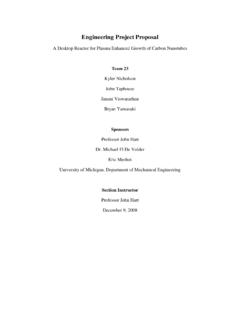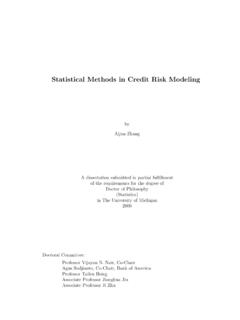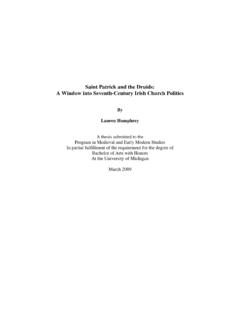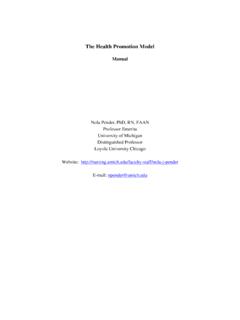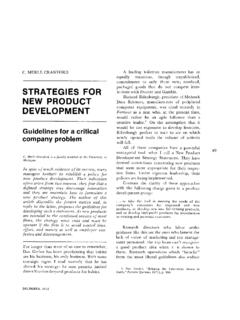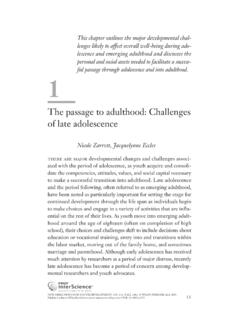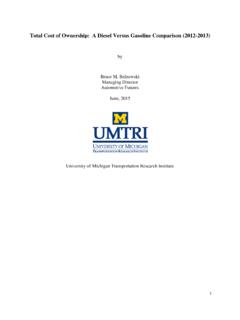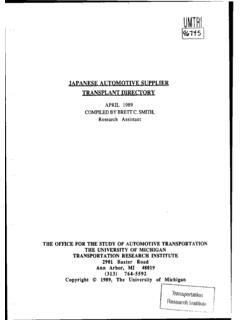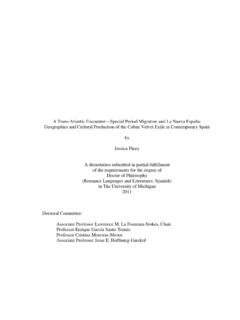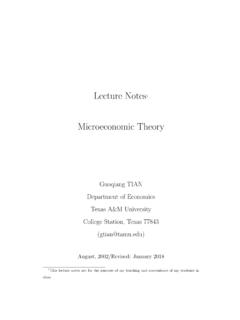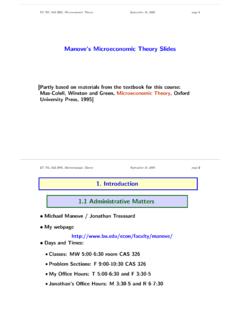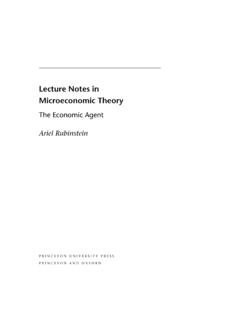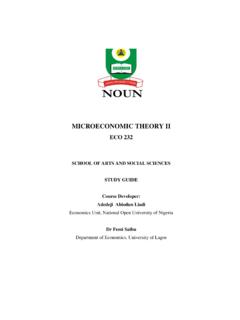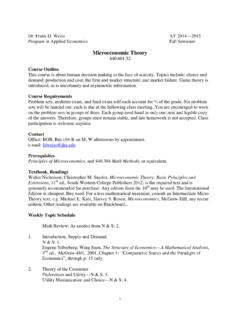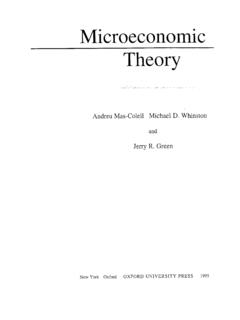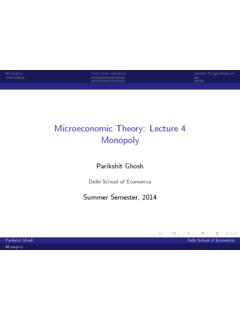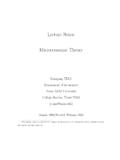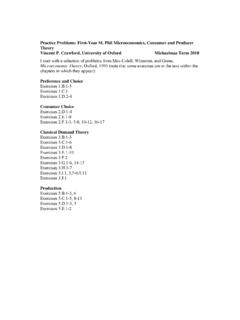Transcription of Essays on Microeconomic Theory - Deep Blue
1 Essays on Microeconomic TheorybyQinggong WuA dissertation submitted in partial fulfillmentof the requirements for the degree ofDoctor of Philosophy(Economics)in The University of Michigan2016 Doctoral Committee:Professor Tilman B orgers, Co-ChairProfessor Stephan Lauermann, University of Bonn, Co-ChairProfessor Kfir Eliaz, Tel Aviv UniversityAssistant Professor David MillerProfessor Scott PageACKNOWLEDGEMENTSMy ancient Chinese ancestors believed that a great work was due more to divine in-spiration than to its earthly deliverer. The work presented here, albeit laying no claimto greatness, has likewise been nourished by many an inspiring mind. In bringing itto fruition I am greatly indebted to my advisors Tilman B orgers and StephanLauermann for their tireless mentoring and encouragement, and also to the othermembers on my committee, namely Kfir Eliaz, David Miller and Scott Page,whose guidances have rendered the work much more wholesome than it could havebecome.
2 The rest of the long list of intellectual creditors are separately acknowledgedin each chapter. Special thanks with love to my wife Haosi, grace of my life, whoseexperience of the travail entailed by the work is no less profound than OF CONTENTSACKNOWLEDGEMENTS..iiLIST OF FIGURES..ivLIST OF APPENDICES..vABSTRACT..viCHAPTERI. A Finite Decentralized Marriage Market with Bilateral Search1II. A Simple Model of Competition Between Teams,jointly withKfir Eliaz..26 III. Coarse Communication and Institution Design..40 APPENDICES..69 BIBLIOGRAPHY..100iiiLIST OF ..62ivLIST OF Proofs and Examples in Chapter 1 .. Proofs and Notation in Chapter 3 ..77vABSTRACTE ssays on Microeconomic TheorybyQinggong WuChairs: Tilman B orgers and Stephan LauermannThe present work collects three Essays on Microeconomic the first essay, I study a model in which a finite number of men and women look forfuture spouses via random meetings.
3 I ask whether equilibrium marriage outcomesare stable matchings when search frictions are small. The answer is they can butneed not be. For any stable matching there is an equilibrium leading to it almostsurely. However unstable even Pareto-dominated matchings may still arise withpositive probability. In addition, inefficiency due to delay may remain significantdespite vanishing search frictions. Finally, a condition is identified under which allequilibria are outcome equivalent, stable, and the second essay, a joint work Kfir Eliaz, we model a competition between twoteams as an all-pay auction with incomplete information. The teams may differ insize and individuals exert effort to increase the performance of one s own team via anadditively separable aggregation function.
4 The team with a higher performance wins,and its members enjoy the prize as a public good. The value of the prize is identicalto members of the same team but is unknown to the other team. We show that thereexists a unique monotone equilibrium in which everyone actively participates, andin this equilibrium a bigger team is more likely to win if the aggregation function isconcave, less likely if convex, or equally likely if the third essay, I study a situation in which a group of people working on a com-mon objective want to share information. Oftentimes information sharing via precisecommunication is impossible and instead information is aggregated by institutionswithin which communication is coarse. The paper proposes a unified framework formodeling a general class of such information-aggregating institutions.
5 Within thisclass, it is shown that institution A outperforms institution B for any common objec-tive if and only if the underlying communication infrastructure of A can be obtainedfrom that of B by a sequence of elementary operations. Each operation either removesredundant communication instruments from B or introduces effective ones to IA Finite Decentralized Marriage Market withBilateral IntroductionThe stable matching is the main solution concept for cooperative two-sided matchingproblems under nontransferable utility. Many centralized mechanisms are designed toimplement stable , whether outcomes of decentralized two-sidedmatching markets correspond to stable matchings remains unclear. The present pa-per addresses this question by considering a decentralized two-sided matching marketmodeled as a search and matching game.
6 Following Gale and Shapley (1962) I inheritthe interpretation that the game represents the situation in which unmarried men andwomen gather in a marketplace to look for future spouses. The game starts with aninitial market `a la Gale-Shapley, henceforth referred to as a marriage market, consist-ing of finitely many men and women with heterogeneous preferences. In every perioda meeting between a randomly selected pair of a man and a woman takes place, dur-ing which they sequentially decide whether to marry each other. Mutual agreementleads to marriage. Married couples leave the game. Disagreement leads to people continue searching. The game ends when no mutually acceptablepairs of a man and a woman are left. Search is costly due to frictions parametrizedas a common discount factor that diminishes the value of a future marriage.
7 Agame outcome, reflecting who has married whom and who stays single, correspondsto a matching for the initial market. The central question addressed in the paper iswhether matchings that obtain in equilibria are stable matchings for the initial marketwhen search frictions are small. The analysis focuses on a near-frictionless setting inorder to test the general conjecture that if in a decentralized market the participantshave easy access to each other with low costs then equilibrium outcomes would be inthe core of the underlying paper shows that the answer to the centralquestion is indeterminate at best and No in general, in contrast to what has been1 See Roth and Sotomayor (1990) for a survey of the Theory of the stable matching.
8 Roth (2008)surveys applications in designing centralized mechanisms for two-sided matching is well known that the core of the marriage market is the set of all stable on this , for any stable matching there is an equilibriumleading to that matching almost surely (Proposition ), that is, every player ex-pects to marry according to the pairing scheme implied by the matching. This resultestablishes that the set of all stable matchings is contained in the set of all matchingsthat may arise in equilibria. Then it is shown that the latter set may contain unstablematchings as well: Under certain preference structures there are equilibria leading toan unstable matching almost surely (Example 1). The paper proceeds to propose twoconditions, each of which rules out such equilibria: 1.
9 The players do not conditiontheir behavior on the actions during any past failed meeting (Proposition ). players preferences satisfy the Sequential Preference Condition, a condition thatimplies a certain degree of preference alignment (Proposition ). However the twoconditions, separately or combined, are not sufficient to rule out equilibria in whichunstable matchings arise with positive probability; some of the probable matchingsmay even be Pareto-dominated (Example 3). Another source of inefficiency is delay:Significant loss of efficiency due to delay may be present in an equilibrium even ifsearch frictions are arbitrarily small (Examples 4 and 5). The paper ends with auniqueness result that is pro-stability and efficiency: If the players preferences sat-isfy a strengthening of the Sequential Preference Condition which implies a strongerdegree of alignment, then all equilibria are outcome equivalent, stable, and efficient(Proposition ).
10 LiteratureThe present paper contributes to the literature on search and matching games in whicha marriage market is embedded. The central question of the literature agrees withthat of the present paper: Do equilibrium outcomes correspond to stable matchings?An early paper in this literature, Roth and Vande Vate (1990) studies the steadystate of a search and matching game with short-sighted players and concludes that astable matching obtains almost surely. Later papers consider sophisticated and Collins (1990), Burdett and Coles (1997), Eeckhout (1999), Bloch andRyder (2000) and Smith (2006) assume that the underlying marriage market admitsa unique stable matching that is positively assortative. Their results confirm thatequilibrium outcomes retain some extent of assorting.
